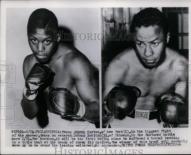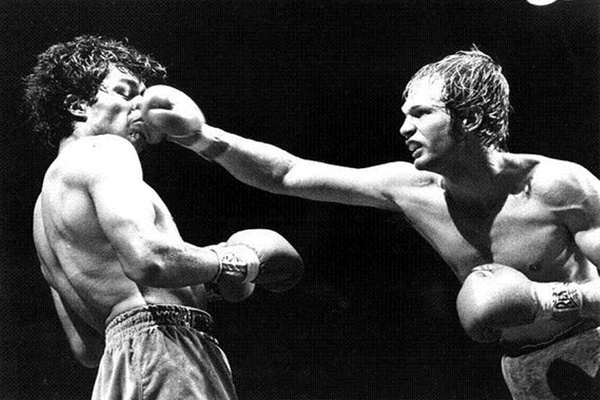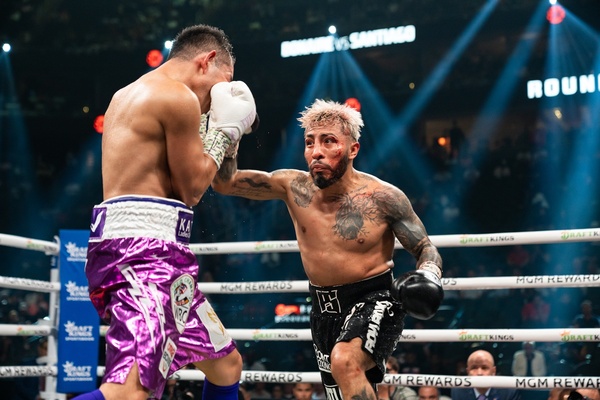A tale of two Johnnys: Johnny Bratton and Johnny Saxton
By John J. Raspanti

This is a story of two former world champions. They were talented fighters, blessed with fast hands and feet. Both won titles in their early twenties, lost them soon after, fought each other, and were broke and out of the game by the age of 28. Their managers were scum. One was a compulsive gambler, the other a mobster.
My dad often spoke of Chicago fighter Johnny Bratton.
“He was so fast, like Sugar Ray Robinson,” said dad a few years before he died. “I saw him win the Golden
Gloves in Chicago. “He was flashy and drove a big Cadillac. We loved him, but something went wrong.”
Bratton had emotional demons that only his family was aware of. He also liked to party. Fast living and boxing don’t usually mix, at least not in the long run. He had discovered he could box purely by chance when, after cutting class in high school, he wandered into a gym.
Within a year he was an amateur star capturing a number of trophies. He turned professional at 17. A guy by the name of Harold Frazier signed him to a contract. Bratton likely knew he couldn’t trust Frazier, but the aroma of big-time money was intoxicating.
Bratton’s pro debut occurred on his 18th birthday. He had 10 fights in six months, winning nine of them. His opponents were a mixture of veterans and contenders. He won most of them but lost some as well. His skill was there, but his discipline wasn’t. In 1946, he defeated contender Willie Joyce at Chicago Stadium. The word was out, the cocky kid who dressed the part could fight.
Bratton’s popularity was growing. He was loaded with charisma and confidence. He was a regular on the Gillete Calalcade of Sports which broadcast fights every Friday night. His style was a mixture of jazzy movement, and mind-numbing power.
Bratton had made over 60 grand in less than two years as a fighter, but had no money in the bank. He had spent it before he made it-purchasing a Jaguar with a license plate that said, “Johnny B.” Frazier didn’t help matters by introducing Bratton to gambling.
Five years into his career, Bratton canned Frazier. He had discovered that the manager was ripping him off. His purses were getting smaller as his fights got more important. When Bratton was motivated, he could beat almost anybody. His first-round knockout over perianal contender Bobby Dykes shocked most boxing experts.
Dykes went into the fight favored. He exited it a loser.
The win earned Bratton a chance at the NBA welterweight champion of the world against Charley Fusari March 14, 1951.
As Bratton prepared for his shot at a title, Johnny Saxton was making a name for himself on the East Coast. Saxton was undefeated in 17 fights, but cracks in his emotional makeup were already showing. His childhood consisted of living with one relative after another before being sent to an orphanage for black children in Brooklyn. The place was a mess. It was old and smelled of rot and sewage. The orphanage wing was finally closed after World War 11.
Saxton appeared to be headed for jail, until a living angel by the name Hortense Pierson became his foster mother. Soon after moving in with Mrs. Pierson, Saxton discovered boxing at a local Police Athletic League. Success came quickly. He won 31 of 33 fights amateur bouts, a Golden Gloves title, and a pair of National AAU championships. Saxton gained valuable experience training with boxing legends Sugar Ray Robinson, Ike Williams, and Sandy Sadler in Harlem. His manager was Bill “Pop” Miller, who also trained Saxton. Miller wanted the best for Saxton. He didn’t want him languishing in clubs barely making a buck.
He was introduced to Frank “Blinky” Palermo, a known mobster. Palermo’s boss was Frankie Carbo, an evil hood who controlled boxing in the 1950s. His method of negotiation was threats, bribes and violence. Miller sold Saxton’s contract for 10,000, with the understanding that he could still work as Saxton’s trainer. Miller thought he had a partner but found out that you don’t make deals with the devil. Within two years, Miller was gone.
Saxton won his first 39 fights, beating such names as Joe Miceli, Luther Rawlings, future Sugar Ray Robinson conqueror Ralph Jones, and former champion Virgil Atkins. Nobody disputed his skill, but Saxton was never popular with fight fans - who didn’t appreciate his mauling tactics. What was disputed was the effort put forth by some of the other fighters Saxton defeated—who reportedly fought like they were sleepwalking. Was the fix in?
All-action contender Gil Turner handed Saxton his first loss in 1953. Nine months later he dropped a split decision to old-pro Del Flanagan. Despite these two setbacks, Palermo had the connections and influence to secure Saxton a title shot. He would fight champion Kid Gavilan in Philadelphia.
----------------------------------------------------------------------------------------------------
The flamboyant Bratton did something he rarely did before he fought Fusari for the vacant NBA crown. He trained hard. Fusari, a good-natured kid from New Jersey, often sparred with former middleweight champion Rocky Graziano. “The Rock” liked the kid, and took him under his wing. When they fought each other in 1949, Graziano had issues with motivation.
Through nine rounds, Graziano was behind on all three judge’s scorecards. Reportedly, seconds before the 10th and final round commenced, Graziano manager Irving Cohen told his fighter that Fusari had been heard spouting off about Graziano’s age and boxing ability. The more Cohen jabbered, the angrier Graziano became.
When the bell rang, Graziano charged after Fusari as if possessed. Growling with rage, he fired haymaker after haymaker, forcing Fusari into the ropes where the referee soon waved off the slaughter. Fusari rebounded to challenge Robinson for the title but lost a one-sided decision. His fight with Bratton would be his last chance at championship honors.
Bratton’s fight against Fusari would be the 60th in his seven-year career. He was 24, older in ring years, due to a number of wars that included two broken jaws. Still he felt good. He would be fighting at Chicago Stadium, site of a number of his fights.
The bout got off to a rip-roaring start. Bratton circled to his left with Fusari in hot pursuit. A Bratton right produced a cut over Fusari’s left eye. Fusari fought back, wobbling Bratton, who instead of staying away, went after Fusari, hurting him with a jolting combination. Bratton, his hands held low, continued to use lateral movement, stabbing Fusari with lefts and lead right hands.
The fight see-sawed back and forth. Bratton took control in round four when he floored Fusari with a perfect right hand. Fusari beat the count, and hung in, tagging Bratton with counterpunches. Bratton sent Fusari to the canvas for the second time in round nine. Both fighters were exhausted, but battled for six more rounds, with the outcome still in doubt. Minutes later, Bratton was announced the winner by split decision.
Johnny Bratton was the new welterweight champion of the world. His payday was the biggest of his career. He had backed up his flash with a gutsy performance. His future appeared bright but a steady decline was about to begin.
----------------------------------------------------------------------------------------------------
On October 20, 1954 in the City of Brotherly Love, Johnny Saxton was awarded a 15- decision over defending champion welterweight Kid Gavilan. The fight was a dull affair from the get go. Saxton backed off, refuse to lead, and held Gavilan every chance he got. One writer called the fight, “Undoubtedly the worst prizefight ever held.”
Gavilan wept in his locker room after the fight. He complained of “getting the business” which in boxing parlance means-the fight was fixed. His complaints carried some weight. Rumors swirled beforehand that the fix was in.
Years after the match author Budd Schulberg told The Observer.
“It was an open secret,” Schulberg said. “All the press knew that one-and other fights-were fixed. Gavilan was a mob-controlled fighter, too, and when he fought Billy Graham it was clear Graham had been robbed of his title. The decision would be bought. If it was close, the judges would shade it the way they had been told.”
It’s unknown whether Saxton suspected anything. He said years later that Gavilan had an off night. Saxton participated in a couple of non-title fights before facing popular Bostonian Tony DeMarco on April Fools Day, 1955. Saxton entered the fight the favorite, but the joke was on the bookies and oddsmakers.
Even the mob figured that Saxton would easily win. His people were so confident of victory, they even agreed to fight DeMarco in his hometown of Boston. DeMarco, fighting in the welterweight division for the first time, had other ideas.
Saxton was expected to box and hold, but, maybe because he was tired of being criticized, or overconfident, Saxton abandoned his safety-first style and choose to slug it out with DeMarco. Bad idea. DeMarco, though the smaller man, could crack. He pressed Saxton to the ropes and left fly with his trademark left hook. Saxton might have fought for the mob, but that didn’t mean lacked courage and grit. He hung in-fighting as hard as he could.
DeMarco landed left hook after left hook, but it was his right that toppled Saxton in the 14th round. The courageous Saxton somehow beat the count, but wobbled sideways, like a drunkard stuck in a hurricane. DeMarco corned Saxton and fired away. Twenty or so blows landed solidly before the referee waved off the contest.
Saxton sat on his stool with a blank look on his puffed-up face. His title was gone, but the Mob wasn’t nearly done with Johnny Saxton.
Though it had taken Bratton seven years to win a world title, there was no rest for the weary. Two months after capturing the crown, Bratton faced Gavilan, the same fighter who would eventually lose his title to Saxton.
Gavilan, who had lost twice to the legendary Robinson, broke Bratton’s jaw in round four and the won the fight by a wide unanimous decision. Bratton demanded a rematch which down six month later in Chicago. Bratton fought as well as he could, but it was obvious to all, except perhaps Bratton, that Gavilan was faster and more talented version of himself. It was fitting that it would be Gavilan who would basically end his career two years later.
Bratton had won five fights in a row against lessor competition when he met Gavilan for the third and final time. Unfortunately, Bratton, still only 26, resembled a much older fighter that night. His hard living and numerous brutal bouts had caught up with him. His reflexes had dulled, and his quick feet couldn’t get him out of a danger. The result was a brutal 15-round beating. Somehow Bratton had made it to the final bell. After the fight he lay on a table unable to move. He was spent physically and mentally. His career was, for all intents and purposes, over, problem was, Bratton didn’t agree.
Bratton’s then-wife Joanne replied years later, “I was resigned to the fact that Johnny would not quit until he made the decision himself.”
Bratton refused. He needed the money. He’d wouldn’t win another fight.
----------------------------------------------------------------------------------------------------
Saxton wasn’t an ex-champion for long. Less than a year after being knocked out by DeMarco, Saxton faced the new titleholder, Carmen Basilio, a no-nonsense battler from New Jersey in Chicago. Basilio fought aggressively, working the body, while Saxton backed off and jabbed. Basilio appeared to have the edge, but it was Saxton who the judges had winning the bout. The crowd reacted with shock and anger after the decision was announced.
Had “Chicago Justice” been served? Was Frankie Carbo rewarding his lieutenant Blinky Palermo for patiently waiting for his fighter to get another shot at a title? Nothing was ever proved. The booing continued long after the fighters had left the ring.
Asked after the fight what had happened, Basilio said, “It was like being robbed in a dark alley.”
Six months later, Saxton and Basilio met again. Basilio trained like a mad man. He wasn’t the fastest, the hardest hitter, or the most talented, but he was always in tip top shape. He considered his rematch with Saxton a do or die match. Saxton was also motivated. He was tired of reading that he had been given he title in Chicago.
Fan favorite Basilio jumped on Saxton in the opening round, Saxton held his ground, fighting like he did against DeMarco the year before. He wanted to show the boxing that he could beat Basilio at his own game. He strafed Basilio’s face with combinations. Basilio bobbed and weaved like a smaller Jack Dempsey. He pounded Saxton’s midsection with bad intentions. By the middle of the fight, Saxton was feeling the effects of Basilio body attack. He tried to stay away more, but Basilio wouldn’t allow it. A big Basilio right split open Saxton’s lip in round seven. By the ninth round, Saxton looked like a balloon with a slow leak. Two punches wobbled him. Basilio forced him against the ropes and let fly with a barrage of blows until the referee stepped in and waved fight off.
A former champion for the second time, Saxton couldn’t understand why the boxing public despised him.
“I don’t know why people don’t like me,” Saxton told Sports Illustrated a few weeks after his loss. “I try had. I have no excuses. He beat me, but the people here don’t like me.”
Saxton wanted a third fight with Basilio.
After losing five fights in a row, Bratton, six months short of his 28th birthday, finally retired from boxing. His body no longer responded to what his big heart asked it to do. He had engaged in 87 fights over a span of 11 years, winning the welterweight title and fighting the best boxers of his era. He had earned an estimated 400,000 dollars but walked away virtually penniless.
---------------------------------------------------------------------------------------------------
Saxton met Basilio for the third time in 1957. The fight was no-contest. Saxton was there in body, but not spirt. Basilio blasted him from pillar to post, staggering him in the first round, and knocking him out in the second. Saxton lost three of his next four fights. His body was falling apart. In his last fight, Saxton was brutalized by up and comer Willie Green. In a touch of irony, the same fate would befall Green six years later. Saxton,28, retired a two-time world champion, with a murky past and no friends. Like Bratton, his ring earnings were gone.
In 1956 Bratton, was admitted to the Manteno State Mental Hospital. In those days, boxing wasn’t taken into consideration when diagnosing brain trauma. The hospital considered him crazy, especially when he kept escaping to downtown Chicago, to listen to music and hang out with old friends. Recognized wherever he went, people gave him money, while others bought him a suit.
A Chicago taxi-cab driver observed.
“Gavilan made his face look like a hamburger, but Johnny wouldn’t go out,” the cabbie told Jet magazine. “He wouldn’t let the South Side down.”
After retiring from boxing, Saxton got a job working the dock. The job paid some of the bills. He had lost his car and house to the IRS. By 1959, he was unemployed and suicidal. He was arrested for stealing five dollars from a department store. A few months later he was arrested again. Soon after, his wife left him.
“I used to take these long walks,” Saxton told sportswriter Dale Shaw. “I didn’t know what to do. I couldn’t fight. I was troubled.”
Two attempts at suicide failed. Saxton was sent to the Ancora State Hospital in New Jersey.
-------------------------------------------------------------------------------------------------
In the 1970s, Bratton was sleeping in the Hotel del Prado in Chicago. He’d make himself useful by running errands and greeting the customers. He’d often slip back into his fighting stance, throwing combination while adding a running commentary. Nobody seemed to mind.
Criminal charges were dropped against Saxton when he was declared insane and punch-drunk in 1962. He still found jobs as a manager at a nightclub and volunteered his time to help to train young fighters. In 1992, he was found living without electricity in a New York City apartment. Sent to a retirement home in Florida, he was found to be suffering from dementia, brought on by his years of boxing.
Around the same time, Johnny Bratton was living in a nursing home on the South Side of Chicago. His life been like an arc of bleakness, to brilliance, and back again. Bratton harbored no bitterness. He told everyone, “He
was doing alright.” He died in 1993 at 65.
I remember my dad mentioning Bratton’s passing to me.
"Such a waste,” said dad. “He had it all.”
Saxton died in 2008, like Bratton, blaming nobody but himself for his problems.
“What I wanted, I wanted,” he said. “What I wanted, I got man.”
Right before he passed away, Bratton was asked if he thought he had been influential in making it possible for later generations of boxers to make big-money.
“Yeah, I did my part. I think I did my part,” said Bratton.
Then he added some words that should be engraved on every fighter’s trunks.
“Save your money.”



Pickup your cpy of Intimate Warfare by Dennis Taylor and John J. Raspanti
www.amazon.com/Intimate-Warfare-Arturo-Boxing-Trilogy/dp/1442273054/ref=sr_1_1?ie=UTF8&qid=1530223046&sr=8-1&keywords=Intimate+warfare
SecondsOut Weekly Newsletter
Permission Statement
If you accept, we will process your data to fulfil this purpose.



